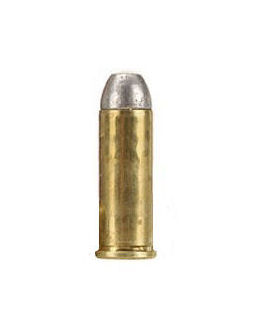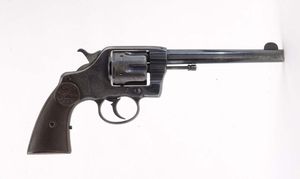
A revolver is a repeating handgun that has at least one barrel and uses a revolving cylinder containing multiple chambers for firing. Because most revolver models hold up to six cartridges, before needing to be reloaded, revolvers are commonly called six shooters.
The 7.62 mm caliber is a nominal caliber used for a number of different cartridges. Historically, this class of cartridge was commonly known as .30 caliber, the equivalent in Imperial and United States Customary measures. It is most commonly used in hunting cartridges. The measurement equals 0.30 inches or three decimal lines, written .3″ and read as three-line.

A derringer is a small handgun that is neither a revolver, semi-automatic pistol, nor machine pistol. It is not to be confused with mini-revolvers or pocket pistols, although some later derringers were manufactured with the pepperbox configuration. The modern derringer is often multi barreled, and is generally the smallest usable handgun of any given caliber and barrel length due to the lack of a moving action, which takes up more space behind the barrel. It is frequently used by women because it is easily concealable in a purse or a stocking.

A semi-automatic pistol is a handgun that automatically ejects and loads cartridges in its chamber after every shot fired. Only one round of ammunition is fired each time the trigger is pulled, as the pistol's fire control group disconnects the trigger mechanism from the firing pin/striker until the trigger has been released and reset.

The Colt Single Action Army is a single-action revolver handgun. It was designed for the U.S. government service revolver trials of 1872 by Colt's Patent Firearms Manufacturing Company and was adopted as the standard-issued pistol of the U.S. Army from 1873 until 1892.

The .45 ACP, also known as .45 Auto, .45 Automatic, or 11.43×23mm is a rimless straight-walled handgun cartridge designed by John Moses Browning in 1904, for use in his prototype Colt semi-automatic pistol. After successful military trials, it was adopted as the standard chambering for Colt's M1911 pistol. The round was developed due to a lack of stopping power experienced in the Moro Rebellion in places like Sulu. The issued ammunition, .38 Long Colt, had proved inadequate, motivating the search for a better cartridge. This experience and the Thompson–LaGarde Tests of 1904 led the Army and the Cavalry to decide that a minimum of .45 caliber was required in a new handgun cartridge.

The .45 Colt (11.43×33mmR), is a rimmed, straight-walled, handgun cartridge dating to 1872. It was originally a black-powder revolver round developed for the Colt Single Action Army revolver. This cartridge was adopted by the U.S. Army in 1873 and served as an official US military handgun cartridge for 19 years, before being replaced by the .38 Long Colt in 1892.

The .38 Long Colt, also known as .38 LC, is a black powder cartridge introduced by Colt's Manufacturing Company in 1875. In 1892, it was adopted as a standard military pistol cartridge by the United States Army for the Colt M1892 revolver. The metric designation for the .38 Long Colt is 9.1×26mm. It is slightly more powerful than the .38 Short Colt, also known as .38 SC. The original .38 SC and .38 LC differ in case length, bullet diameter, weight, and design and are not interchangeable; however, modern production .38 SC ammunition is now loaded with a smaller, internally-lubricated bullet which can be fired from firearms chambered in .38 LC or .38 Special. The modern .38 LC can be fired from .38 Special firearm, but not from a firearm designed for the .38 SC, since the case length is too long.

The .45 Schofield, also referred to as .45 Smith & Wesson is a revolver cartridge developed by Smith & Wesson for their S&W Model 3 Schofield top-break revolver. It is similar to the .45 Colt cartridge, but with a shorter case and a larger rim. The. 45 Schofield will generally work in revolvers chambered for that cartridge; but the reverse is not true, since the .45 Colt case is longer. United States government arsenals supplied .45 Schofield cartridges for the Schofield revolver and the Colt Army revolver to help simplify their armament needs.

In American English, a pocket pistol is any small, pocket-sized semi-automatic pistol, and is suitable for concealed carry in a pocket or a similar small space.

The .41 Long Colt cartridge was created in 1877 for Colt's double-action "Thunderer" revolver.

The Colt Model 1900 is a short-recoil operated "self-loading", or semi-automatic .38 caliber handgun introduced by Colt's Manufacturing Company at the turn of the 20th century. The M1900 was the first firearm to be chambered in .38 ACP and was the first handgun to utilize short-recoil operation.

A snubnosed revolver is a small, medium, or large frame revolver with a short barrel, generally less than 4 inches in length. Smaller such revolvers are often made with "bobbed" or "shrouded" hammers and there are also "hammerless" models ; the point is to allow the gun to be drawn with little risk of it snagging on clothing. Since the external movement of the mechanism is minimal or nil, shrouded and hammerless models may be fired from within clothing. The design of these revolvers compromises range and accuracy at a distance in favor of maneuverability and ease of carry and concealment.

A handgun is a firearm designed to be usable with only one hand. It is distinguished from a long gun which needs to be held by both hands and braced against the shoulder. Handguns have shorter effective ranges compared to long guns, and are much harder to shoot accurately. While most early handguns are single-shot pistols, the two most common types of handguns used in modern times are revolvers and semi-automatic pistols, although other handguns such as derringers and machine pistols also see infrequent usage.

The .32 Long Colt is an American centerfire revolver cartridge.

The Colt New Service is a large frame, large caliber, double-action revolver made by Colt from 1898 until 1941. Made in various calibers, the .45 Colt version with a 5½" barrel, was adopted by the U.S. Armed Forces as the Model 1909.

The Colt M1892 Navy and Army was the first general issue double-action revolver with a swing out cylinder used by the U.S. military.

The Colt M1877 was a double-action revolver manufactured by Colt's Patent Fire Arms from January 1877 until 1909 for a total of 166,849 revolvers. The Model 1877 was offered in three calibers, which lent them three unofficial names: the "Thunderer", the "Lightning", and the "Rainmaker". The principal difference between the models was the cartridge in which they were chambered for, these are the "Thunderer" in .41 Long Colt; the "Lightning" in .38 Long Colt; and the "Rainmaker" in .32 Long Colt. All of the models had a six-round capacity.

The Colt New Line was a single action pocket revolver introduced by the Colt's Patent Fire Arms Manufacturing Company in 1873.

The Colt Model 1871–72 Open Top is a metallic cartridge rear-loading .44-caliber revolver introduced in 1872 by the Colt's Patent Fire Arms Manufacturing Company. This handgun was developed following two patents, the first one in 1871 and the second one in 1872, it is estimated that the production span lies primarily between February 1872 and June 1873. There is therefore still some confusion when naming it. It is sometimes named Colt Model 1871 or Colt Model 1872 but at this time the most common accepted names are Colt Model 1871–72 Open Top, Colt Model 1871–72 or simply Colt Open Top.





















